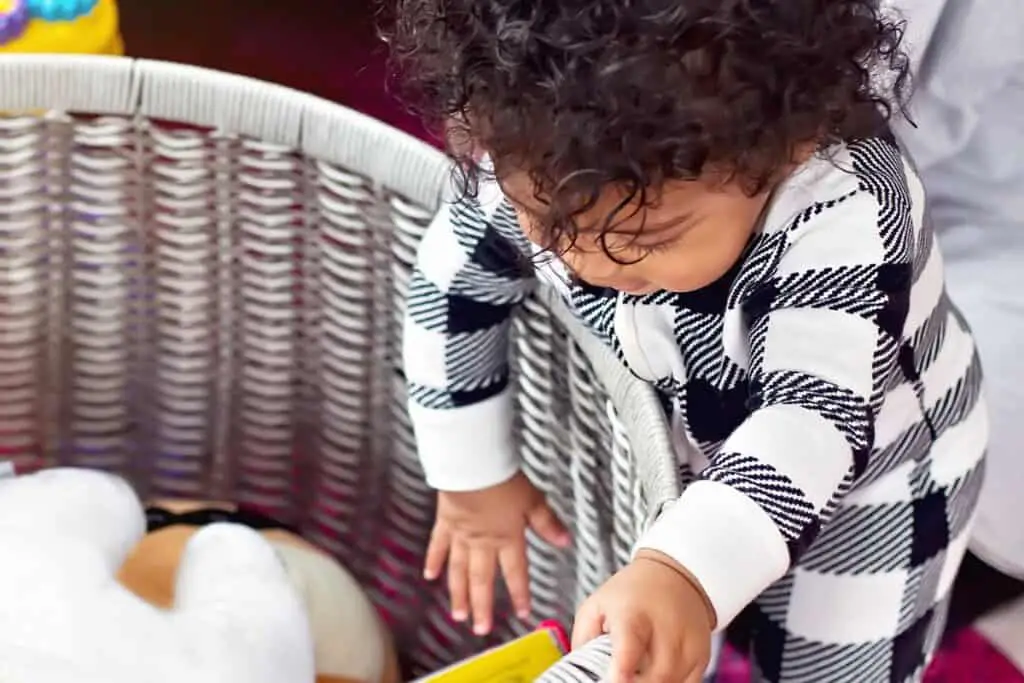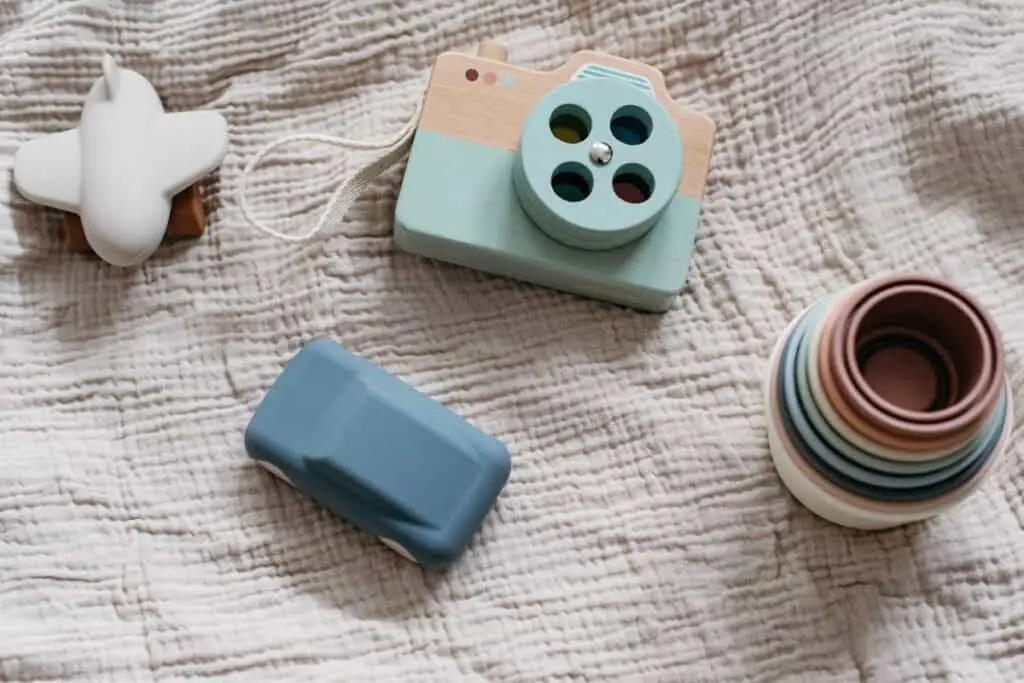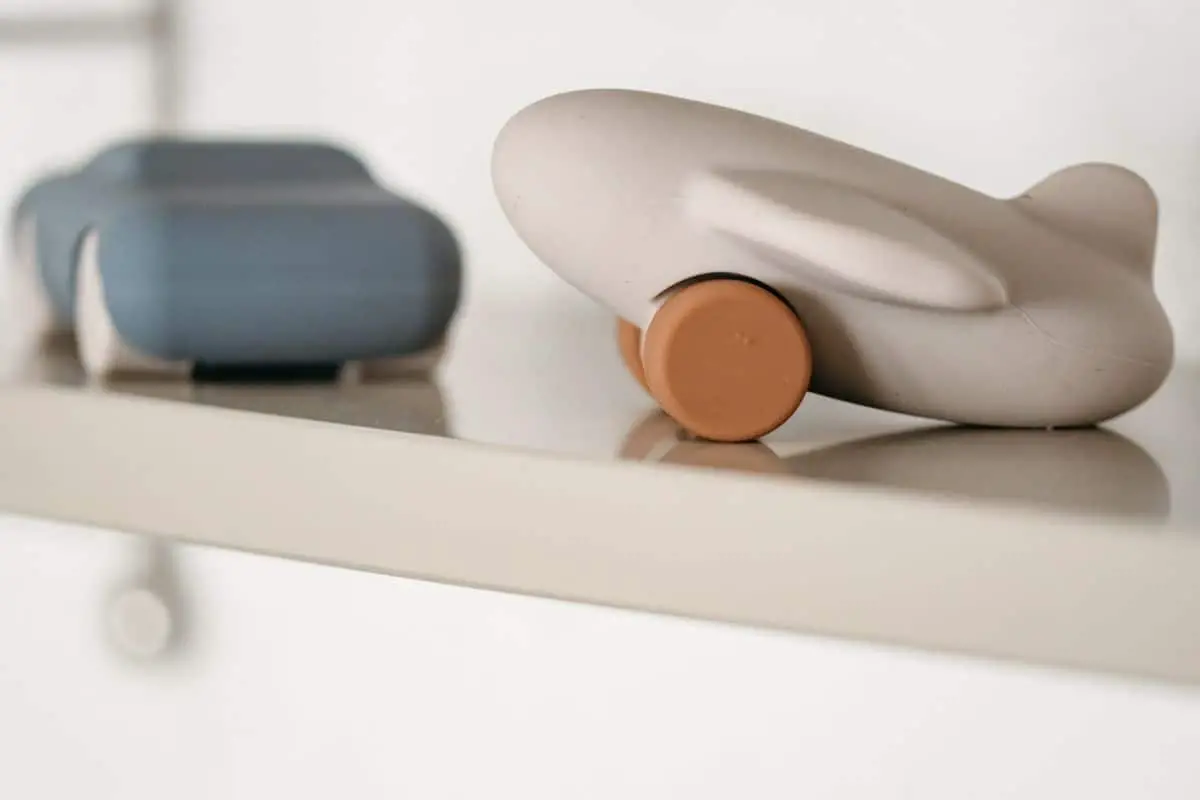It can be tough to keep a playroom organized and functional on a budget. It’s hard to keep up with the mess kids create, not to mention that constant flow of new toys into the house.
Using the tips in this article, you can easily organize your child’s space and make it both fun and functional!
1. Identify The Source of Toy Clutter
The first step in organizing your child’s playroom is to identify the source of toy clutter. Most parents are surprised to learn that their child owns WAY more toys than they think. In a survey of 1,000 parents with children aged 2-12, it was found that the average child owns 238 toys but the parents only thought their child owned 5% of that.
This means that most parents are buying more toys than their children are playing with on a daily basis. This excess accumulation of toys not only creates clutter and chaos in your home, but also prevents your child from enjoying playing time. Too many toys can also lead to distractions and more cleaning up for you.
It’s important to remember that too many toys are not only an unnecessary waste of money, but they’re also bad for your child. Excessive ownership can lead to less focus and attention span during playtime. So before you go out and buy any more toys, take some time to assess the situation and figure out what steps need to be taken.
2. Declutter
When it comes to decluttering, inspiration can come from many different places. For some people, it might be children who provide the impetus to start getting rid of things. After all, kids have a way of inspiring us to do just about anything! They’re also not as sentimental as adults, so they can help us get rid of things more quickly.
Another great source of inspiration for decluttering is other adults. Sometimes we need someone else’s point of view to see how much stuff we’ve accumulated over the years. And once we see it through their eyes, we might be more likely to get rid of it quickly.
Of course, there are always those times when motivation is hard to find. That’s when garbage bags or donation bins come in handy! If you need a little extra push to get started, these methods will help you out. Plus, you can always donate your unwanted items to friends and family members who could use them more than you do.
3. Consider a Toy Rotation
If you’re looking for ways to organize a playroom on a budget, consider implementing a toy rotation system. A toy rotation will prevent you from buying new ones, and keep your kids engaged with their old favorites. It can be achieved without bins or baskets, and is a great way to avoid boredom.
The bottom section of the toy storage area is open so that toddlers can easily access them at their whim. We rotate toys to keep them from getting bored.
4. Focus on the storage

One of the most important aspects of decorating a playroom is storage. Make sure there are bins and compartments for different sizes so that everything has its place. This will help keep the room looking neat and organized, which is especially important when space is limited.
A budget-friendly storage solution can help you meet your needs for the playroom without spending too much money on furniture that might not get used once your child grows out of playing with toys. Storage benches are great for holding toys that your child might not want to play with but which will be needed later on by other children. Adding a decorative basket to the storage bench is helpful for hiding toys.
Repurposing other furniture, such as dressers and cabinets, allows you to make new toy storage units out of them. Avoid using furniture with sharp corners or rough edges. If you’re handy with power tools, build your own storage units to hide away all your kid’s toys. Beware of large pieces of furniture toppling over when children are playing on them.
When thinking of ways to organize toys, the cardboard boxes can be used as a toy storage solution. They’re readily available and free if you have some lying around from moving or buying new items. Hanging shelving is a good way to make use of wall space in small spaces–the smaller shelves can hold books, toys, and other items while the floor storage space is ideal for larger items like stuffed animals or balls. Cute shelving can also add visual interest to the room and help solve the toy storage problem at the same time.
5. Make the floor comfortable.
One way to make the floor more comfortable for your kids is by adding floor pillows. This is a great, affordable way to add soft seating and comfort. You can find these in a variety of colors and patterns, so they’ll match any room’s décor.
Another way to make the floor more comfortable is by using a bean bag cover. This large cover can hold dozens of stuffed animals, which makes it perfect for hours of playtime fun. Plus, the cover is machine-washable, so it’s easy to keep clean.
6. Pick the right paint
When painting your playroom, it’s important to pick the right paint. You’ll want a paint that is easy to clean up – preferably one that dries quickly so you can get rid of any messy drawings or spatters as soon as possible. Washable paint is essential in this high-traffic area!
7. Purchase items that grow with your kids
One of the best ways to save money in the long run is to purchase furniture that will grow with your children. This way, you won’t have to replace items as they outgrow them and can instead buy new pieces when they’re older and need something more appropriate for their size.
Some great examples of furniture that grows with kids are adjustable table and chair sets–which often come at a lower price point than full-size furniture–and larger items like bunk beds or sofas that can accommodate multiple children. If you’re on a tight budget, these may be better options for you than buying several smaller pieces of furniture.
8. Decorate with a neutral theme
When decorating a playroom, it is important to think about the future. You want to select a design that will grow with your child and be enjoyable for years to come. This means avoiding character specific designs and selecting a more general theme instead.
There are many themes you can choose from based on your child’s preferences. One popular option is “old Macdonald had a farm.” This theme incorporates animals, nature, and farming into the décor, providing endless possibilities for creativity and exploration. If your child prefers something more modern, you could go with a space or transportation theme. With either choice, avoid overly themed rooms that will quickly become outdated.
A good way to start when decorating with color is to use neutral schemes. This allows you to gradually add pops of color as your child grows older and develops new interests. Neutral colors also help the playroom blend in better with the rest of your home, making it feel like one cohesive space rather than two separate ones. When choosing paint or wallpaper, stick to light shades like whites, grays, and beiges so that the room never feels too busy or overwhelming for little ones.
9. Categorize & Create busy Boxes
The key to organizing the toys was categorizing them according to function and activity. This way, it would be easy for your child to remember where everything is. The categories that you can use are: books, art supplies, building blocks & cars, dress-up clothes & accessories, and dolls & stuffed animals.
You can also create ‘busy boxes’ in various locations around the house. These are designated spaces with activities or materials that correspond with the theme of the box. For example, the kitchen is a busy box that has a real play kitchen inside of it, which can be used alongside his real materials. The living room is the only playroom with limited storage space.
10. Categorize Toys and Label

When organizing a playroom, it is important to consider how to categorize the toys. This will help keep things organized and make it easier for the children to find what they are looking for. One way to categorize toys is by type. This could include placing all board games in one area, all dolls in another and cars in another.
Another way to categorize toys is by age if you have children of different ages sharing the same room. A playroom can have multiple sections: one for toddlers, and another for older kids. Label each section so that all the children know where everything goes.
Getting kids involved is the best way to help them put toys back in their proper place after playing with them. There are many ways to involve children in organizing toys, from sorting and labeling toy boxes to “inventor” games where they can build something new out of old toys.
11. Install Wall Hooks
One of the easiest and cheapest ways to organize a playroom is to install wall hooks. They can be used to store hats, scarves, capes, backpacks, and bags. They are also a great way to add decoration to a room.
Hooks are easy to install and come in a variety of shapes and sizes. Make sure you choose hooks that can be easily accessed by your child so they can grab what they need without difficulty.
If you’re looking for an attractive way to display artwork in a playroom, consider using a curtain rod with hooks. It’s an affordable solution that doesn’t take up too much space on the wall. Plus, it’s easy for multiple children to use without being obtrusive.
12. Decorate With Fabric Baskets On Open Shelves
One great way to add some extra storage and style to your playroom is by using fabric baskets on open shelves. Not only do these baskets serve as a place to store toys, books, or other items, but they can also be used as decorative pieces in the room.
There are many different types of fabric baskets available, so you can find one that perfectly matches the look and feel of your playroom. And since they come in a variety of shapes and sizes, you can choose ones that fit perfectly on the shelves.
Another great thing about using fabric baskets on open shelves is that they are very versatile. You can use them to store just about anything – from toys and books to clothes and blankets. Plus, when you’re not using them for storage, you can easily move them around or take them with you wherever you go.
13. Stations to Put in a Playroom When Designing With Purposeful Play in Mind
When designing a playroom, it’s important to consider what kind of stations you want to put in the room. Doing this will help you maximize the potential for purposeful play. Here are some ideas:
- A work station can include a small table and chair with a task light, as well as shelves for organizing art supplies and other materials.
- A dress-up station can include a mirror, clothing racks or hooks, and storage containers for accessories.
- A reading nook can include comfortable seating and a small table or shelf for books and other materials.
- An exploration zone can include tents, tunnels, large boxes, balls, and other items that promote movement and creativity.
- A music area can include instruments (real or pretend), sound-proofing material if desired, storage for music materials, and seating.
- A construction zone can include building blocks of all shapes and sizes, tool benches with toy tools,, crates or milk jugs filled with sand or water for making mud pies, etc.
Final Thoughts
It can be tough to keep a playroom organized and functional on a budget. It’s hard to keep up with the mess kids create, not to mention that constant flow of new toys into the house.
Now that you have some ideas about how to organize a playroom on a budget, it’s time to get started! By using the tips in this article, you can create a space that is both fun and functional for your child. Don’t forget to take advantage of the many storage options available, including fabric baskets, bins, and shelves. And of course, don’t forget the easiest tip of all, which is to own less!

